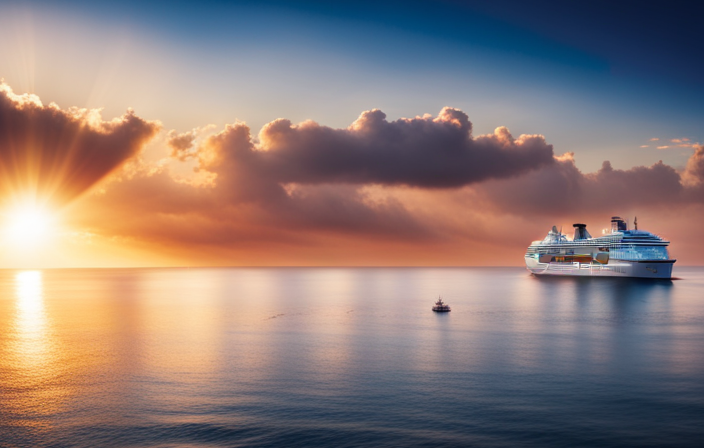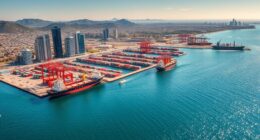Did you know that in just a week, a cruise ship can produce over a million gallons of sewage? This astonishing statistic highlights the urgent necessity for efficient sewage handling on these floating cities. In this article, my goal is to delve into the complexities of sewage management on cruise ships, encompassing the technologies and strategies used to deal with this waste, as well as the environmental regulations that govern these practices.
From toilets to treatment plants, I will take you behind the scenes to understand how cruise ships manage their sewage. We will also discuss the health and safety measures implemented to protect passengers and crew members, as well as the waste reduction and recycling initiatives that aim to minimize the impact on the environment.
Technology plays a crucial role in sewage management, and we will explore the innovative solutions being implemented by the industry. Additionally, we will examine public perception and consumer awareness, as well as cruise line policies and industry standards.
Join me on this journey to discover the world of cruise ship sewage management and explore the path towards a clean and sustainable future.
Key Takeaways
- Proper sewage management on cruise ships is crucial for the marine ecosystem.
- Advanced technologies and treatment processes are used to remove contaminants from sewage.
- Cruise ships have sophisticated onboard sewage systems that include toilets, holding tanks, and treatment plants.
- Compliance with strict environmental regulations is necessary to prevent fines and penalties for cruise ship operators.
The Importance of Sewage Management on Cruise Ships
Managing sewage on cruise ships is of utmost importance due to the complex ecosystem of waste flowing through the ship’s pipes. Sewage treatment processes are crucial for ensuring proper treatment of waste before it is discharged into the ocean. Without effective sewage management, the impact on marine ecosystems can be devastating.
Cruise ships have implemented advanced technologies to treat sewage onboard. These technologies include biological treatment systems and advanced oxidation processes. These systems effectively remove harmful substances and pathogens from the wastewater, making it safe for discharge. In addition, the treated sewage often undergoes further disinfection processes to ensure it meets strict environmental standards.
The onboard sewage system, from toilets to treatment plants, is a critical component in maintaining the health and sustainability of our oceans.
The Onboard Sewage System: From Toilets to Treatment Plants
Cruise ships have a sophisticated onboard sewage system that includes toilets, holding tanks, and wastewater treatment plants. The waste from toilets is collected and stored in holding tanks equipped with sensors. When these tanks need to be emptied, the crew is alerted. The waste is then transported to the ship’s wastewater treatment plant. At the treatment plant, the wastewater undergoes several processes to remove impurities and pollutants. These processes include screening, sedimentation, and disinfection. Once the water is treated, it is discharged into the ocean, following strict environmental regulations. Cruise ships must adhere to these regulations to protect marine life and the environment. The onboard sewage system is crucial for maintaining the cleanliness and sustainability of cruise ship operations.
In the subsequent section about environmental regulations and compliance, it is important to understand the impact of these regulations on the cruise industry.
Environmental Regulations and Compliance
When it comes to environmental regulations and compliance, it’s astounding to consider that over 90% of cruise passengers are not aware that these strict measures are in place to protect the marine ecosystem. Cruise ships are subject to a range of international and national regulations that govern the treatment and disposal of sewage onboard.
These regulations are in place to mitigate health risks and prevent pollution of the marine environment. Failure to comply with these regulations can have serious legal implications for cruise ship operators, including fines and penalties.
To ensure compliance, cruise ships are equipped with advanced sewage treatment plants that treat wastewater before it is discharged into the ocean. These treatment plants use a combination of physical, chemical, and biological processes to remove contaminants and reduce the environmental impact of sewage.
These measures are just one aspect of the comprehensive health and safety measures implemented by the cruise industry to protect passengers and the marine environment.
Transitioning into the subsequent section about ‘health and safety measures’, it is important to understand the steps taken to ensure the well-being of everyone onboard.
Health and Safety Measures
Passengers aboard cruise liners can rest assured knowing that stringent health and safety measures are in place to protect their well-being. The importance of training, monitoring, and evaluation cannot be overstated when it comes to ensuring the safety of passengers and crew members.
Cruise ships are subject to regulatory compliance and inspections to guarantee that wastewater treatment technologies are effectively implemented. This is crucial to mitigate the impact on marine ecosystems and prevent potential health risks associated with improper sewage management.
Cruise ship waste management strategies include the use of sewage treatment facilities and onboard waste management systems. These systems adhere to wastewater discharge regulations and are designed to minimize public health concerns. By prioritizing effective onboard waste management, cruise lines are able to maintain a safe and healthy environment for all passengers.
This focus on health and safety transitions seamlessly into waste reduction and recycling initiatives.
Waste Reduction and Recycling Initiatives
To truly experience the impact of waste reduction and recycling initiatives, you’ll be amazed at how cruise liners prioritize sustainability and create a greener future. Waste reduction is a key focus for cruise ships, as they aim to minimize the amount of waste generated on board. This is done through various measures, such as implementing efficient waste management systems and encouraging passengers to reduce waste through responsible consumption.
Recycling initiatives play a crucial role in this process, with cruise liners implementing comprehensive recycling programs for different types of waste, including paper, plastic, glass, and metal. These programs ensure that recyclable materials are properly sorted and processed, reducing the amount of waste that ends up in landfills or incinerators.
By embracing waste reduction and recycling initiatives, cruise liners are taking proactive steps to minimize their environmental impact and contribute to a more sustainable future. As we explore the potential challenges and solutions in waste management on cruise ships, it becomes evident that these initiatives are a crucial part of creating a cleaner and greener industry.
Potential Challenges and Solutions
Managing waste on board a floating city, where every item you dispose of can impact the ocean’s delicate ecosystems, is an immense task. When it comes to sewage treatment on cruise ships, there are several challenges that need to be addressed.
Firstly, the sheer volume of sewage generated by thousands of passengers and crew members poses a significant challenge. Secondly, the treatment process must comply with strict environmental regulations to ensure that harmful substances are removed before discharge.
To overcome these challenges, innovative solutions for sewage management have been developed. These include advanced wastewater treatment systems that utilize biological processes to break down organic matter and remove contaminants. Additionally, some cruise ships are implementing onboard sewage treatment plants, which allow for the safe and efficient processing of waste.
Transitioning into the subsequent section about the role of technology in sewage management, it is clear that advancements in this area are crucial to ensuring the sustainability of cruise ship operations.
The Role of Technology in Sewage Management
Technology plays a crucial role in managing waste on board floating cities, utilizing innovative solutions like advanced wastewater treatment systems and onboard sewage treatment plants. The role of automation in waste treatment has significantly improved the efficiency and effectiveness of sewage management on cruise ships. Technological advancements have allowed for the development of sophisticated systems that can process and treat sewage in an environmentally friendly manner. These systems are equipped with sensors and control mechanisms that monitor and regulate the treatment process, ensuring optimal performance. Additionally, the use of advanced filtration and disinfection technologies helps to remove contaminants and pathogens from the wastewater, making it safe for discharge into the ocean.
| Advantages of Technology in Sewage Management |
|---|
| Increased treatment efficiency |
| Enhanced environmental protection |
| Improved water quality |
| Reduced risk of contamination |
With such advancements, public perception and consumer awareness about sewage management on cruise ships are gradually changing.
Public Perception and Consumer Awareness
Transparency and communication are crucial for public perception and consumer awareness regarding sewage management on cruise ships. Cruise lines need to be transparent about their sewage treatment processes and communicate this information to the public. This allows consumers to make informed decisions and hold cruise lines accountable for their environmental practices.
Environmental responsibility and sustainability are important factors for consumers when choosing a cruise line. They expect cruise lines to implement sustainable sewage management practices to minimize their impact on the environment.
Consumer advocacy and pressure groups also play a vital role in raising awareness and pressuring cruise lines to adopt more environmentally-friendly sewage management practices. These groups advocate for stricter regulations and encourage consumers to support cruise lines that prioritize environmental responsibility.
Transparency and Communication
Transparency issues and communication challenges surround the topic of sewage on cruise ships. Many cruise lines fail to provide detailed information about their sewage treatment processes, leaving passengers in the dark. Some companies only report on the volume of sewage discharged, without mentioning the treatment methods or the potential impact on the environment. There is no universal standard for sewage treatment on cruise ships, leading to inconsistencies in practices and accountability. Independent audits are rarely conducted, making it difficult to assess the accuracy of the information provided by cruise lines. There is a pressing need for cruise companies to be more transparent and forthcoming about their sewage management practices.
Now, let’s dive into the next section on environmental responsibility and sustainability, where we explore how cruise lines can minimize their ecological footprint.
Environmental Responsibility and Sustainability
Cruise lines can actively contribute to preserving the environment by implementing sustainable practices that reduce their ecological impact. One key area where they can make a difference is in the management of wastewater generated on board.
The environmental impact of cruise ship sewage is a significant concern, as it contains various pollutants and contaminants that can harm marine ecosystems. To address this issue, cruise lines have invested in advanced wastewater treatment systems that effectively remove harmful substances before the treated water is discharged back into the ocean. These systems use a combination of physical, biological, and chemical processes to ensure that the wastewater meets strict regulatory standards.
By adopting these measures, cruise lines demonstrate their commitment to environmental responsibility and sustainability. Moving forward, it is crucial for consumer advocacy and pressure groups to continue pushing for even more stringent regulations and monitoring of cruise ship wastewater discharge.
Consumer Advocacy and Pressure Groups
Consumer advocacy and pressure groups play a critical role in raising awareness and pressuring cruise lines to adopt more sustainable practices. These groups work tirelessly to hold cruise lines accountable for their environmental actions and advocate for stricter regulations.
Firstly, they highlight the harmful effects of cruise ship wastewater, such as the discharge of untreated sewage and the release of harmful chemicals into the ocean. This evokes a sense of concern for the well-being of marine life and the overall health of our oceans.
Secondly, they expose instances of cruise lines violating environmental regulations and emphasize the need for stronger enforcement. This creates a sense of anger and frustration towards companies that prioritize profit over the environment.
Lastly, they encourage consumers to be more conscious of the environmental impact of their cruise choices. This empowers individuals to make informed decisions and demand change from the industry.
With consumer advocacy and pressure groups at the forefront, it is imperative for cruise lines to reassess their policies and industry standards to ensure the long-term sustainability of our marine ecosystems.
Cruise Line Policies and Industry Standards
In terms of cruise line policies and industry standards, two key points to consider are corporate social responsibility initiatives and collaboration among companies to share best practices.
Cruise lines are increasingly focusing on implementing sustainable practices and initiatives to reduce their environmental impact and contribute to the communities they visit.
Additionally, collaboration among cruise lines allows for the sharing of best practices, lessons learned, and innovative ideas to continually improve the industry’s standards and practices.
These efforts ensure that cruise lines are actively working towards responsible and sustainable operations.
Corporate Social Responsibility Initiatives
One way cruise companies can demonstrate their commitment to social responsibility is through their initiatives. Corporate transparency and stakeholder engagement are key components of these initiatives, as cruise companies strive to be accountable to their customers, employees, and the communities they operate in. These initiatives often involve implementing sustainable practices, supporting local economies, and giving back to the community through various philanthropic efforts.
To provide a visual representation of these initiatives, the table below highlights some common corporate social responsibility initiatives undertaken by cruise companies.
| Initiative | Description | Example |
|---|---|---|
| Environmental sustainability | Implementing measures to reduce the environmental impact of cruise operations | Investing in advanced waste management systems to minimize the environmental footprint |
| Community development | Supporting local communities through various economic and social initiatives | Partnering with local organizations to provide education and healthcare services to residents |
| Philanthropy and volunteerism | Contributing to charitable causes and encouraging employees to engage in volunteer activities | Donating funds and organizing volunteer trips to assist in disaster relief efforts |
As cruise companies continue to prioritize corporate social responsibility, collaboration and sharing best practices will be crucial for further progress in the industry.
Collaboration and Sharing Best Practices
To make progress in the industry, you can collaborate with other companies and share best practices for corporate social responsibility initiatives. This collaboration allows for the exchange of knowledge and the opportunity for collaborative research. By working together, companies can pool resources and expertise to find innovative solutions for sewage management on cruise ships.
Here are three key benefits of collaboration and sharing best practices:
-
Increased efficiency: By sharing best practices, companies can learn from each other’s successes and failures. This knowledge exchange allows for the implementation of more efficient and effective sewage management systems.
-
Cost savings: Collaborative research can lead to the development of cost-effective solutions for sewage treatment on cruise ships. By sharing resources and expertise, companies can reduce research and development costs.
-
Improved environmental performance: Sharing best practices enables companies to jointly address environmental challenges. Through collaboration, they can develop sustainable sewage management practices that minimize the impact on marine ecosystems.
With collaboration and knowledge exchange, we can work towards a clean and sustainable future for cruise ship sewage management.
Conclusion: A Clean and Sustainable Future for Cruise Ship Sewage Management
With a focus on a clean and sustainable future for cruise ship sewage management, it’s fascinating to note that approximately 70% of cruise ships now have advanced wastewater treatment systems in place. These systems play a crucial role in ensuring that sewage is treated properly before being discharged into the ocean.
One of the key aspects of a sustainable future for cruise ship sewage management is the use of clean energy and innovative technologies. Many cruise ships are now utilizing renewable energy sources such as solar power and wind turbines to power their wastewater treatment systems.
Additionally, innovative technologies like membrane bioreactors and advanced oxidation processes are being employed to further enhance the treatment of sewage onboard. These advancements not only contribute to a cleaner and healthier marine environment but also demonstrate the industry’s commitment to responsible wastewater management.
Frequently Asked Questions
How often is the sewage system on a cruise ship inspected and maintained?
The inspection frequency and maintenance procedures for cruise ship sewage systems vary depending on the ship and regulations. However, regular inspections and maintenance are conducted to ensure proper functioning and compliance with environmental standards.
What happens to sewage on a cruise ship when it is not properly managed?
When sewage on a cruise ship is not properly managed, it can lead to sewage contamination, causing significant environmental impact. This includes pollution of the surrounding water, harm to marine life, and potential spread of diseases.
Are there any potential health risks to passengers and crew members if the sewage system malfunctions?
If the sewage system on a cruise ship malfunctions, there are potential health risks to both passengers and crew members. Bacterial contamination, the spread of diseases, and unpleasant odors are some of the consequences that can occur.
How do cruise lines ensure compliance with environmental regulations regarding sewage management?
Cruise lines ensure compliance with environmental regulations regarding sewage management through compliance monitoring and environmental impact assessments. These measures help to ensure that the sewage systems are properly maintained and that any potential environmental impacts are minimized and mitigated.
What measures are in place to prevent sewage spills or leaks into the ocean?
To prevent sewage spills or leaks into the ocean, cruise ships have stringent measures in place. Advanced sewage treatment systems and waste disposal technologies ensure that no harm is done to the environment.
Does the sewage on cruise ships affect the quality of the water they use?
Yes, the sewage on cruise ships can definitely affect the quality of the cruise ship water source. Improper treatment and disposal of sewage can lead to contamination of the water source, posing health risks to passengers and crew. It’s crucial for cruise lines to properly manage their sewage to ensure safe water quality.
How Can I Ensure Proper Disposal of Sewage on a Cruise Ship Before Booking a Deal?
When looking for the best cruise deals available, ensure that the cruise ship has proper sewage disposal measures. Research the ship’s environmental policies and check if they adhere to international regulations. Prioritize booking with a cruise line that prioritizes responsible waste management to enjoy a guilt-free vacation.
Conclusion
In conclusion, the importance of proper sewage management on cruise ships cannot be overstated. By implementing advanced technologies and adhering to environmental regulations, cruise lines are working towards a clean and sustainable future.
As we sail towards this future, let us remember that every drop of sewage holds the potential for both harm and renewal. Just as a river flows, carrying both life and remnants of the past, let us strive to navigate these waters with care, ensuring a safe and healthy voyage for all.
Alfons is the visionary leader and driving force behind Voyager Info’s success. As the Editor in Chief, he brings a wealth of experience and an unwavering passion for travel to the helm of our cruise-centric platform.
With a lifelong fascination for exploring new horizons, Alfons discovered his love for the ocean and cruising at a young age. From sailing across pristine Caribbean waters to embarking on daring expeditions to far-flung destinations, he has amassed a treasure trove of first-hand experiences in the world of cruising.











